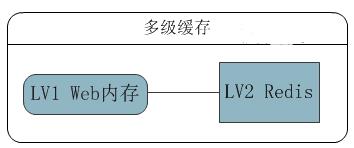浅谈缓存写法:内存缓存该如何设计
Posted
tags:
篇首语:本文由小常识网(cha138.com)小编为大家整理,主要介绍了浅谈缓存写法:内存缓存该如何设计相关的知识,希望对你有一定的参考价值。
分析设计假设有个项目有比较高的并发量,要用到多级缓存,如下:

在实际设计一个内存缓存前,需要考虑的问题:
1:内存与Redis的数据置换,尽可能在内存中提高数据命中率,减少下一级的压力。
2:内存容量的限制,需要控制缓存数量。
3:热点数据更新不同,需要可配置单个key过期时间。
4:良好的缓存过期删除策略。
5:缓存数据结构的复杂度尽可能的低。
关于置换及命中率:采用LRU算法,因为它实现简单,缓存key命中率也很好。
LRU即是:把最近最少访问的数据给淘汰掉,经常被访问到即是热点数据。
关于LRU数据结构:因为key优先级提升和key淘汰,所以需要顺序结构,网上大多实现都采用的这种链表结构。
即新数据插入到链表头部、被命中时的数据移动到头部,添加复杂度O(1),移动和获取复杂度O(N)。
有没复杂度更低的呢? 有Dictionary,复杂度为O(1),性能最好。 那如何保证缓存的优先级提升呢?
O(1)LRU实现
定义个LRUCache<TValue>类,构造参数maxKeySize 来控制缓存最大数量。
使用ConcurrentDictionary来作为我们的缓存容器,并能保证线程安全。
<pre style="margin:0px;
padding:0px;
white-space:pre-wrap;
overflow-wrap:break-word;
font-family:"
Courier New"
!important;
font-size:12px !important;
"> public class LRUCache<TValue>:IEnumerable<KeyValuePair<string,TValue>> {
private long ageToDiscard = 0;
//淘汰的年龄起点
private long currentAge = 0;
//当前缓存最新年龄
private int maxSize = 0;
//缓存最大容量
private readonly ConcurrentDictionary<string,TrackValue> cache;
public LRUCache(int maxKeySize) {
cache = new ConcurrentDictionary<string,TrackValue>();
maxSize = maxKeySize;
}
}
</pre>上面定义了?ageToDiscard、currentAge?这2个自增值参数,作用是标记缓存列表中各个key的新旧程度。
实现步骤如下:
每次添加key时,currentAge自增并将currentAge值分配给这个缓存值的age,currentAge一直自增。
<pre style="margin:0px;
padding:0px;
white-space:pre-wrap;
overflow-wrap:break-word;
font-family:"
Courier New"
!important;
font-size:12px !important;
"> public void Add(string key,TValue value) {
Adjust(key);
var result = new TrackValue(this,value);
cache.AddOrUpdate(key,result,(k,o) => result);
}
public class TrackValue {
public readonly TValue Value;
public long Age;
public TrackValue(LRUCache<TValue> lv,TValue tv) {
Age = Interlocked.Increment(ref lv.currentAge);
Value = tv;
}
}
</pre>在添加时,如超过最大数量,检查字典里是否有ageToDiscard年龄的key,如没有循环自增检查,有则删除、添加成功。
其ageToDiscard+maxSize=?currentAge?,这样设计就能在O(1)下保证可以淘汰旧数据,而不是使用链表移动。?
<pre style="margin:0px;
padding:0px;
white-space:pre-wrap;
overflow-wrap:break-word;
font-family:"
Courier New"
!important;
font-size:12px !important;
"> public void Adjust(string key) {
while (cache.Count >= maxSize) {
long ageToDelete = Interlocked.Increment(ref ageToDiscard);
var toDiscard = cache.FirstOrDefault(p => p.Value.Age == ageToDelete);
if (toDiscard.Key == null) continue;
TrackValue old;
cache.TryRemove(toDiscard.Key,out old);
}
}</pre>获取key的时候表示它又被人访问,将最新的currentAge赋值给它,增加它的年龄:
<pre style="margin:0px;
padding:0px;
white-space:pre-wrap;
overflow-wrap:break-word;
font-family:"
Courier New"
!important;
font-size:12px !important;
"> public TValue Get(string key) {
TrackValue value=null;
if (cache.TryGetValue(key,out value)) {
value.Age = Interlocked.Increment(ref currentAge);
}
return value.Value;}
</pre>过期删除策略
大多数情况下,LRU算法对热点数据命中率是很高的。 但如果突然大量偶发性的数据访问,会让内存中存放大量冷数据,也即是缓存污染。
会引起LRU无法命中热点数据,导致缓存系统命中率急剧下降,也可以使用LRU-K、2Q、MQ等变种算法来提高命中率。
过期配置
通过设定最大过期时间来尽量避免冷数据常驻内存。
多数情况每个数据缓存的时间要求不一致的,所以需要再增加单个key的过期时间字段。
<pre style="margin:0px;
padding:0px;
white-space:pre-wrap;
overflow-wrap:break-word;
font-family:"
Courier New"
!important;
font-size:12px !important;
"> private TimeSpan maxTime;
public LRUCache(int maxKeySize,TimeSpan maxExpireTime) {
}//TrackValue增加创建时间和过期时间
public readonly DateTime CreateTime;
public readonly TimeSpan ExpireTime;
</pre>删除策略
关于key过期删除,最好的方式是使用定时删除,这样可以最快的释放被占用的内存,但很明显大量的定时器对CPU来说是非常不友好的。
所以需要采用惰性删除、在获取key的时检查是否过期,过期直接删除。
<pre style="margin:0px;
padding:0px;
white-space:pre-wrap;
overflow-wrap:break-word;
font-family:"
Courier New"
!important;
font-size:12px !important;
">public Tuple<TrackValue,bool> CheckExpire(string key) {
TrackValue result;
if (cache.TryGetValue(key,out result)) {
var age = DateTime.Now.Subtract(result.CreateTime);
if (age >= maxTime || age >= result.ExpireTime) {
TrackValue old;
cache.TryRemove(key,out old);
return Tuple.Create(default(TrackValue),false);
}
}return Tuple.Create(result,true);}
</pre>惰性删除虽然性能最好,但对于冷数据来说还是没解决缓存污染的问题,所以还需增加个定期清理和惰性删除配合使用。
比如单开个线程每5分钟去遍历检查key是否过期,这个时间策略是可配置的,如果缓存数量较多可分批遍历检查。
<pre style="margin:0px;
padding:0px;
white-space:pre-wrap;
overflow-wrap:break-word;
font-family:"
Courier New"
!important;
font-size:12px !important;
">public void Inspection() {
foreach (var item in this) {
CheckExpire(item.Key);
}
}
</pre>惰性删除配合定期删除基本上能满足绝大多数要求了。
总结
本篇参考了redis、Orleans的相关实现。
如果继续完善下去就是内存数据库的雏形,类似redis,比如增加删除key的通知回调,支持更多的数据类型存储。
以上是关于浅谈缓存写法:内存缓存该如何设计的主要内容,如果未能解决你的问题,请参考以下文章